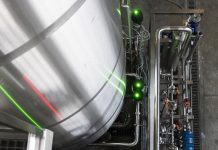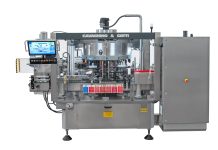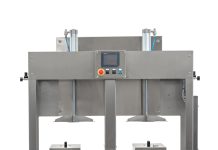In enology, the separation of solids from liquids can be carried out through different processes:
• filtration
• centrifugation
• sedimentation
• flotation
Flotation is founded on the following principle: the substances that have tendency to get wet go down, while those that don’t have this tendency float. Moreover, the particles can be covered by a layer of gas, (generally nitrogen) so reducing their apparent specific weight, they float easily. It is possible to write the mass budgets (figure 1), referred both to solid-and to liquid phase, where:
• L = must to be floated (m3/h)
• F = sediment (m3/h)
• M = clear must (m3/h)
• xL = concentration of solids in the must to be floated (kg/m3)
• xF = concentration of solids in sediment (kg/m3)
• xM = concentration of solids in clear must (kg/m3)
Hence:
L = F + M
LxL = FxF + MxM
from which is deduced:
F = L[(XL – XM)/(XF – XM)]
Similarly, it is possible to deduce the M value:
M = A[(XA – XF)/(XM – XF)]
To calculate the volume of the flotation tank, it is necessary to refer to the following parameters:
• t, permanence time (h)
• Q, mass flow rate (kg/h)
• q, specific mass flow rate (kg/m3 h)
• v, volumetric flow rate (m3/h)
• V, cell volume (m3)
where:
q = xL/t [kg/m3 h]
Q = XL*v [kg/h]
the cell volume will be:
V = Q/q [m3]
that is
V = (XL*v)*(t/XL) = v*t [m3]
The layout of a must flotation plant consists of: a must feeding and mixing system with adjuvant, an inert gas dissolver (at a pressure of a few bars), a separation tank equipped with a rotating system for the removal of sediments. New system solutions show, also, the collecting of the must directly from the tank, its mixing with gas at high pressure inside a mixing cylinder and, finally, the re-input in the tank from which it was taken. Such solutions have been recently tested on Cortese grape originating GAVI D.O.C.G. at the wine cellar La Bollina S.p.A., Serravalle (AL) by the institute of Enology and Food Engineering, of Università Cattolica del Sacro Cuore of Piacenza. The experimentation compared a “Traditional” thesis (A), that was a cold static sedimentation, with a “Flotation ” thesis (B) in which must clarification was carried out through nitrogen injection at the bottom of the tank. In both cases, pectin enzymes were added and, after about one hour, sulphur dioxide at the doses normally used by the wine cellar was put. The clarification phase was performed under the above-mentioned conditions, at a temperature of about 12°C. The flotation system collects the must from the bottom of the tank, adds nitrogen through a pump with a Venturi system (0.5 Nm3/h flow rate input of nitrogen) and, subsequently it increases the pressure of the mixture gas-liquid in a mixing cylinder up to 5 bar. Finally, the mixture is re-introduced in the tank. The pump’s flow rate is 100 hl/h.
Once the clarification phase is over, the volumes of clear phase (clarified final must) and the percentage of solids separated in the 2 cases were measured (table 1). In the B thesis, Flotation, solids are completely floated at the top of the tank, while by the traditional system, during decanting, the elimination of more quantity of liquid phase together with separated solids was noticed. Nevertheless, the samples collected during flotation and analyzed relatively to the content of suspended solids that float in the must, highlight interesting results (table 2), from which useful and practical indications can be drawn.
It was noticed that the A thesis, traditional, clarified through static clarification for 12 h, at the end of the operation, has a concentration of solids of 0,85 g/L. Therefore, the static clarification phase reduced the initial content of solids of about 93%. In the “Flotation ” test solids are completely floated at the top of the tank, with a must cleaning degree, just at the end of gas insertion phase (sample B3), of 3,12 g/l, with a 80% separation efficiency in 1 h work time. Solids, accumulated at the top of the tank during flotation, subsequently have the tendency to sediment, because of they pushed downward due to gravity. Therefore, in the hypothesis to adopt such solution, it is advisable to quickly separate the floated product; if not, another suspension of solids in the liquid can be noticed. In fact, after 12 h, in the B thesis a more elevated concentration of solids remains, equal to 7,28 g/L and, therefore, the reduction of turbid value goes down to about 54%.
After decanting, the same doses of nutrients were added to the clarified musts in order to proceed with fermentation in separate tanks, but in similar conditions. Before and after the alcoholic fermentation the varietal aromatic compounds were analyzed and, at the end of fermentation, the fermentative aromas were dosed too. The aroma profile (figure 2) show that, with flotation at high nitrogen pressure, oxygen stripping from the liquid mass induced by flotation favors, for musts and white wines, the creation of a positive “reduced” environment. Nevertheless, with this system a sensitive reduction of terpenols, compounds of which the Cortese di Gavi grape is rich, was noticed as far as the stripping of volatile molecules. The more reductive conditions favor the development of an aromatic profile mainly characterized by “green” notes. With static sedimentation remain in the must both elevated terpene alcohols, and redox conditions such to promote a good aromatic intensity, in which “sweet” molecules are mainly distinguished. Sensory analysis, carried out on the wine samples some weeks after alcoholic fermentation, confirms what was noticed during analytical control, showing:
– for the wine obtained by high pressure flotation, a general agreeability, with a thin taste-olfactory profile and a modest aftertaste persistence;
– for the wine obtained by static sedimentation, a greater global agreeability, with an elegant taste-olfactory profile and a more intense taste-olfactory persistence.
| Must total volume | Clarified must | Solids | |
| Test A | 50 hL | 41 hL | 18.0% |
| Test B | 50 hL | 47 hL | 6.0% |
Tab. 1 – Total volume of initial must and of the related clarified liquid phase. Percentage of solids eliminated from must
| Static sedimentation | Suspended solids (g/L) | |
| Initial must | A1 | 12.8 |
| Clarified must | A2 | 0.85 |
| Flotation | ||
| Initial must | B1 | 15.8 |
| Pre-flotation | B2 | 11.9 |
| Post-flotation | B3 | 3.1 |
| Clarified must | B4 | 7.3 |
Tab. 2 – Suspended solids from must samples collected during experimental trials
Fig. 1 – Simplified outline of a flotation system
Fig. 2 – Aromatic profile of the wines obtained during the three experimental tests
by Milena Lambri, Institute of Enology and Food Engineering, Catholic University of Sacro Cuore






